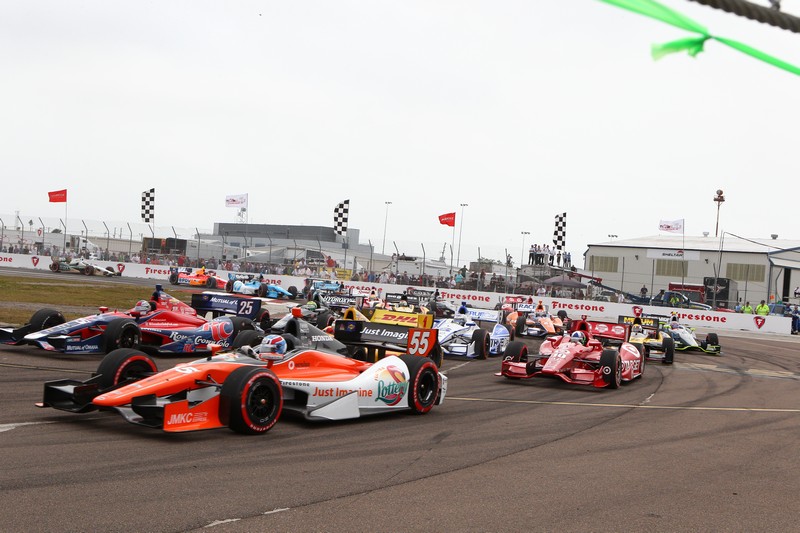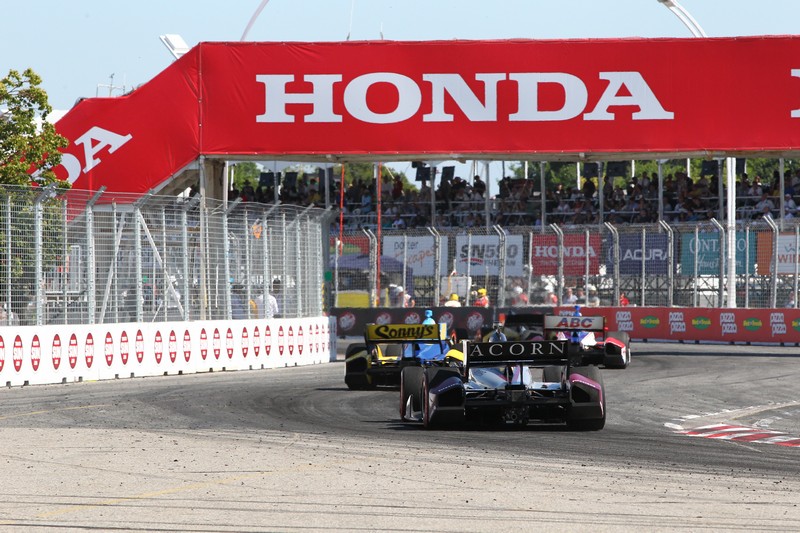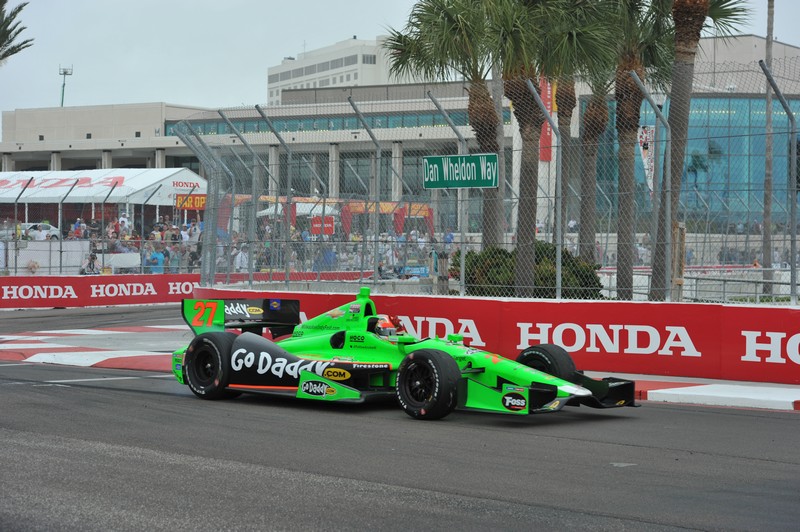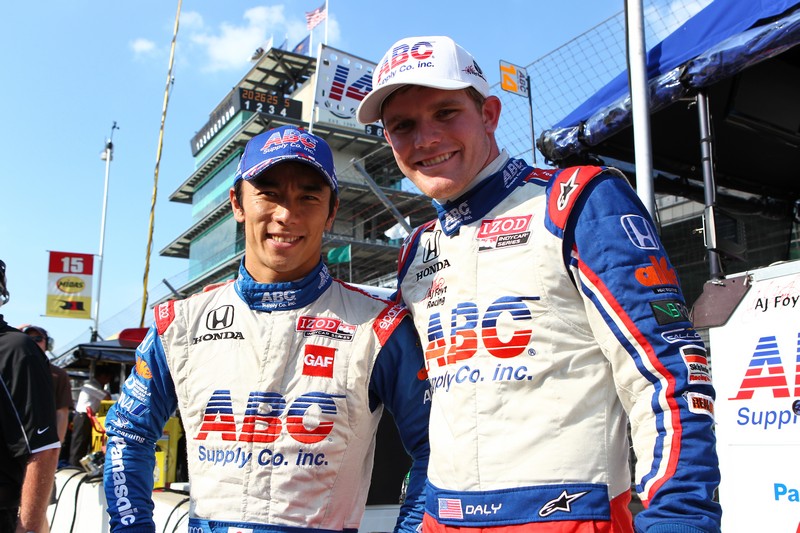
The start of the 2014 IndyCar Series season on the streets of St. Petersburg, Florida is a mere three weeks away and while I am looking forward to it, there’s a feeling of unease I can’t seem to shake.
Like most years, this one features new team and driver combinations, tweaks to the schedule and rules (which includes a new qualifying format for the Indianapolis 500), along with other changes.
It’s pretty much par for the course, although I will be interested to see how the compressed schedule (the season finale in Fontana is set for Aug. 30) will affect the championship and whether the new qualifying format for the Indy 500 will actually produce more drama (and thus greater interest), something it has had precious little of (at least to these eyes) in recent years.
All of this should, at the very least, make for an interesting season, but when my mind drifts to the bigger picture and the overall health of the sport, that’s when I start to feel a bit concerned.
If I had to pinpoint the reasons for my concern, it relates to several recent developments.
The first is connected to season opener, the Firestone Grand Prix of St. Petersburg, which is now sporting a new title sponsor for the first time since it began in 2005. While I am pleased to see Firestone step into the void created by Honda’s departure, I wonder if this is the last shoe to drop.
 Honda (both in the U.S. and Canada) has been a stalwart sponsor of IndyCar racing, from its role as an engine supplier through its U.S. racing arm Honda Performance Development (HPD), to title sponsorship of several races (Barber, Mid-Ohio, Toronto) on the schedule, plus all of the millions it spends to market the sport, both at the track and on television.
Honda (both in the U.S. and Canada) has been a stalwart sponsor of IndyCar racing, from its role as an engine supplier through its U.S. racing arm Honda Performance Development (HPD), to title sponsorship of several races (Barber, Mid-Ohio, Toronto) on the schedule, plus all of the millions it spends to market the sport, both at the track and on television.
With the exception of Firestone, no other corporation has been as solidly in the IndyCar corner over the past two decades as Honda. And while I am certain its involvement in the sport has helped it sell lots of cars over the years, it has come at a pretty steep cost. The company has stated it loses money – millions annually – on its engine supply contract, and its race sponsorships deals consume money, they don’t generate it.
Exiting the St. Petersburg race after a long partnership, combined with a growing desire to reduce its engine supply burden – Honda has deals with 12 full-time 2014 entries, while its only competitor, Chevrolet, has 10 – makes me wonder if management at American Honda has finally decided its time to begin to, if not leave the sport altogether, then to at least trim the losses stemming from its involvement.
To me, this makes Cosworth’s reported desire to return to its role as an IndyCar engine supplier vital to Honda’s long-term commitment to the sport. Cosworth CEO Hal Reisiger has indicated in recent interviews that the company is developing an IndyCar engine and could return, if an OEM partner is found, by next year’s Indy 500 and in a full-time capacity by 2016. I hope it happens, for everyone’s sake.
Something else connected to St. Pete that concerns me is the size of the grid. As some may be aware, my employer (Performance Publications) has been a long-time partner of the race, having produced the official souvenir program since 2010. While assembling the materials for this year’s guide, I was struck by the departure of, not only several stalwart drivers (Dario Franchitti, Alex Tagliani and Simona de Silvestro among others), but also entrants (Dreyer & Reinbold and Dragon Racing will not field cars at St. Pete, although D&R could return for the Indy 500), and most importantly, sponsors.
 The drain of notable sponsors from IndyCar since the end of 2013 is nothing short of alarming. While much of the focus is, understandably, on who will step up to fill the vacated series sponsor role after IZOD’s departure, what’s been happening at the team level is of greater concern to me.
The drain of notable sponsors from IndyCar since the end of 2013 is nothing short of alarming. While much of the focus is, understandably, on who will step up to fill the vacated series sponsor role after IZOD’s departure, what’s been happening at the team level is of greater concern to me.
Having a big corporation support the series is wonderful, and it does add millions to IndyCar’s revenue stream, but it’s those that fund individual entries that keep cars on the grid, and a lot of those companies have said adios in the past six months.
Among those that left are: Barracuda Networks, Citgo, GoDaddy, Hewlett-Packard, McAfee, Nuclear Clean Air Energy, TBC Retail Group (which owns Midas, Service Central and several other automotive retailers in the U.S.) and TrueCar.
Added to others that have departed in recent years, like 7-Eleven and Motorola, it’s starting to make me wonder what would happen if DHL, Target and Verizon decide they’ve had enough of spending huge amounts of money on diminishing returns and choose to leave too. Best not to think about that, I guess.
The exodus of these companies is directly connected to something else I find concerning, which is the introduction of new drivers into the sport or, more accurately, the lack thereof.
I was involved in a rather passionate Facebook discussion on the subject this past week, and the centre of it was the plight of Conor Daly, son of Derek, the former F1 and IndyCar driver.
The younger Daly is without a ride – of any kind – in 2014, and he expressed some of his frustration about his circumstances in a recent interview with Autoweek.
Now, Daly is just 22, and given his talent (he’s won in a variety of junior open-wheel series both in North America and Europe) and his apparent determination to land a ride, his chances of lasting the entire season without any races under his belt are slim. An Indy 500 deal appears likely and other races could be added should he be able to put the necessary funding together.
Ah yes, funding – something most IndyCar drivers have to be concerned about securing on an annual basis.
 Look, I’m well aware that to make it as a professional driver in this day and age it takes a lot more than talent, but at what point does the sport risk blowing its future simply because many of its most promising future stars don’t have access to unlimited wealth?
Look, I’m well aware that to make it as a professional driver in this day and age it takes a lot more than talent, but at what point does the sport risk blowing its future simply because many of its most promising future stars don’t have access to unlimited wealth?
Many that were involved in the conversation about Daly (pictured, right, with team mate Takuma Sato at the 2013 Indy 500) have years of experience covering racing, and are independent business people who know how challenging it can be to keep a business (and a career) afloat.
Yet, despite that reality, it seemed like I was one of the few that felt much sympathy for a rising open-wheel star with talent and pedigree, and an American to boot, who can’t seem to land a full-time IndyCar ride.
Hey, I love watching TK and Helio too, and I’m eager to see how Montoya performs in his first season in an open-wheel race car of any kind since 2006, but all of them are approaching 40. How many more seasons do they have left in them? Are they all going to have to retire before kids like Daly get their shot?
And if some don’t think Daly’s status as an American matters (which I think is absurd), consider that IndyCar lives and dies with American media and corporate interest. Having strong Americans in the series is important; it does move the needle.
Closer to home, there is a glut of Canadians populating the junior open-wheel formulas at the moment. Where are they going to be in 2016 or ‘17? Forced into sports cars or out of racing all together because they don’t have rich relatives to underwrite their racing careers?
This brings me back to the exodus of sponsors from the sport. I have no doubt that if a few of the companies I mentioned were still involved, Conor Daly and others like him would be on the grid for the season-opener in St. Pete.
 I understand that attracting and retaining sponsors is challenging, and is made all the more difficult by the stubbornly low TV ratings IndyCar racing suffers from (particularly in the U.S.) aside from the Indy 500. It’s a difficult task, and I’m not exactly sure how (or if) it can be improved. Maybe it can’t be, but I hope I’m wrong about that.
I understand that attracting and retaining sponsors is challenging, and is made all the more difficult by the stubbornly low TV ratings IndyCar racing suffers from (particularly in the U.S.) aside from the Indy 500. It’s a difficult task, and I’m not exactly sure how (or if) it can be improved. Maybe it can’t be, but I hope I’m wrong about that.
Despite my concerns about the upward mobility of young drivers into IndyCar, I’m going to close on a positive note.
This past week, 23 year-old Jack Hawksworth of Bradford, England (pictured above) was named as the full-time driver of the no. 98 Dallara/Honda for Bryan Herta Autosport. Hawksworth, the 2012 Star Mazda champion and three-time race winner in Indy Lights last season will make his IndyCar debut in St. Pete.
I wish him well, and hope he’ll soon be joined by other young, exciting racers who are there not just because they’ve mastered the art of self-promotion and are loved by sponsors, but also because they’re pretty damn good behind the wheel of a race car. That, after all, is their real job.
Photography by INDYCAR






















